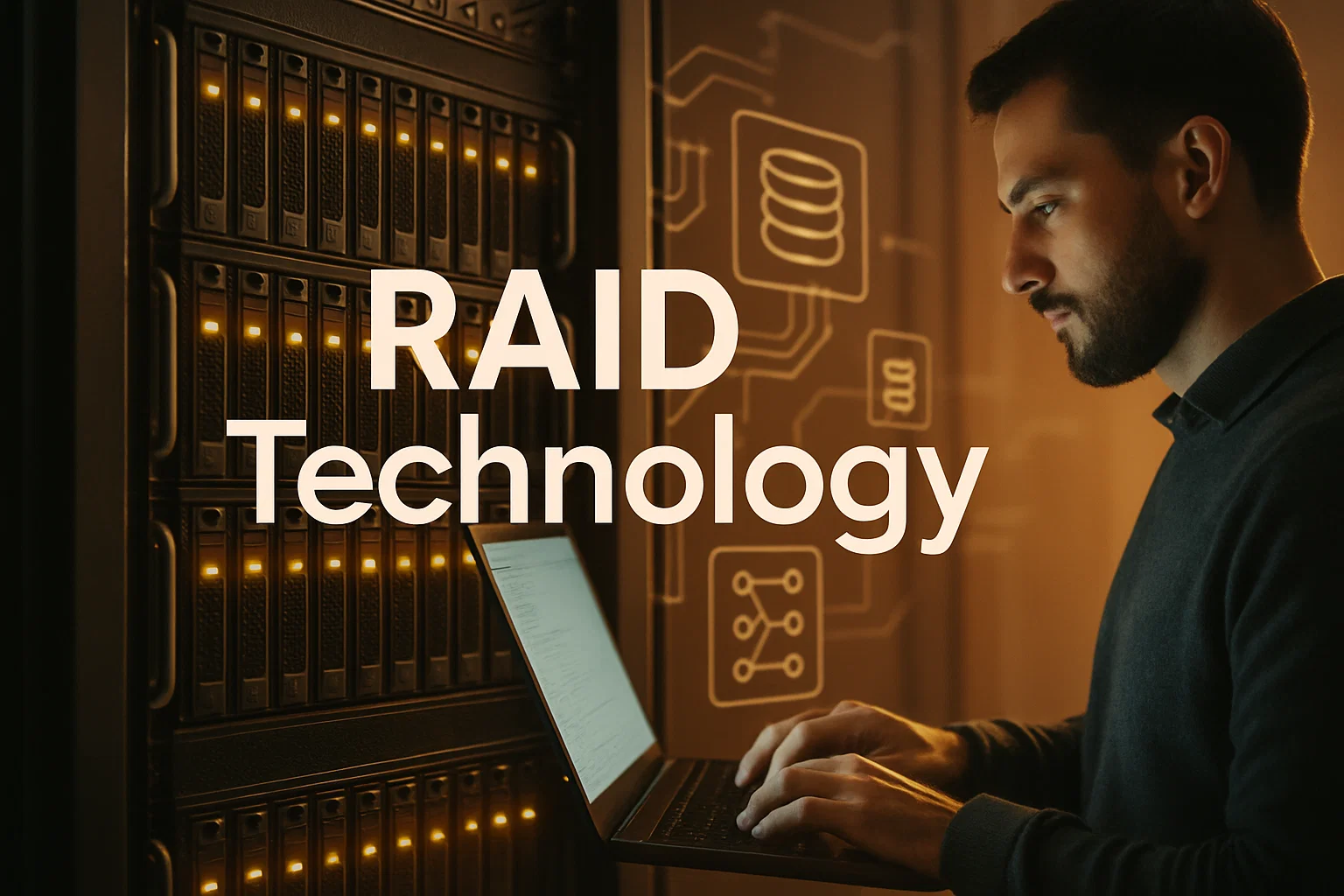Raid technology lets you balance performance, capacity, and redundancy by choosing the right RAID level and tooling, this guide explains concepts, step-by-step implementation, recommended tools, troubleshooting, and a compliance checklist so you can deploy reliable storage systems.
Introduction
raid technology plays a critical role when you need reliable storage, and this article is informational with actionable steps to help you choose and implement the right RAID strategy. You will learn core RAID concepts, how to pick a level for performance versus redundancy, practical setup steps, and ways to monitor and recover from failures. I’ll mention related entities like SAN and NAS early so you can map RAID options to real infrastructure. In my experience, a short pilot and a clear backup plan save more time than over-optimizing for peak performance. Read on to get practical examples, copy-pasteable scripts, tool recommendations, and a clear compliance checklist to keep your data safe.
What raid technology is, and why it matters
Raid technology groups multiple drives to present a single logical volume with improved speed, capacity, or fault tolerance. RAID stands for redundant array of independent disks, and it has evolved from simple mirroring and striping to advanced parity, nested levels, and software-defined implementations.
Core RAID concepts
- Striping, spreads data across drives to improve throughput.
- Mirroring, duplicates data for immediate redundancy.
- Parity, stores parity info to reconstruct data after a failure.
- Hot spares, standby drives that auto-replace a failed disk.
Why RAID matters to you
If you manage servers, virtual machines, or storage arrays, RAID technology affects uptime, data integrity, and application performance. Choosing the wrong level can either waste storage or expose you to data loss. For databases and critical services, redundancy and quick rebuilds are often more important than raw capacity.
RAID in modern systems
Today RAID appears in hardware RAID controllers, software RAID (mdadm on Linux), and in hyperconverged or cloud platforms where erasure coding and replication replace traditional RAID in some contexts. Knowing basic RAID trade-offs helps you plan backups, monitoring, and disaster recovery.
Properly configured storage arrays reduce downtime and speed recovery, by combining redundancy and monitored health checks. (official docs)
How to choose and implement RAID technology, step-by-step
Follow this practical workflow to choose a RAID level and deploy it safely.
- Define your goals
- Decide whether you need higher read/write speed, maximum capacity, or resilience. For databases, prioritize redundancy and low latency. For media storage, capacity might be higher priority.
- Pick the RAID level
- Common choices: RAID 1 for mirroring, RAID 5 for parity with capacity efficiency, RAID 6 for two-disk fault tolerance, RAID 10 for performance and redundancy. Choose based on drive count and failure tolerance.
- Assess hardware vs software RAID
- Hardware RAID offloads parity calculations to a controller, reducing CPU load. Software RAID like
mdadmis flexible and simpler to manage at scale. - Plan for rebuilds and spare capacity
- Rebuild times grow with drive size, so plan hot spares and monitor rebuild performance to avoid data stress during a rebuild.
- Prototype on a non-production system
- Test with realistic workload using synthetic IO (fio) or real app tests, measure latency and throughput.
- Implement monitoring and alerting
- Track SMART attributes, array health, and rebuild progress. Automate alerts for degraded states.
- Document and backup
- Keep clear documentation of array layout, backup schedules, and recovery steps.
Example: create software RAID with mdadm (Linux)
# shell
# Create RAID 1 array from two devices, with basic error handling
sudo mdadm --create --verbose /dev/md0 --level=1 --raid-devices=2 /dev/sdb /dev/sdc || { echo "RAID create failed"; exit 1; }
sudo mkfs.ext4 /dev/md0
sudo mkdir -p /mnt/storage && sudo mount /dev/md0 /mnt/storage
echo "/dev/md0 /mnt/storage ext4 defaults 0 0" | sudo tee -a /etc/fstab
Explanation: This shell snippet uses mdadm to build a mirrored RAID 1 array, formats it, mounts it, and adds an fstab entry for persistence. Test in a safe environment before running on real devices.
Example: check SMART health with Python
# python
# Simple wrapper to run smartctl and parse exit status, minimal error handling
import subprocess
def check_smart(device="/dev/sda"):
try:
res = subprocess.run(["smartctl", "-H", device], capture_output=True, text=True, timeout=10)
return res.stdout
except Exception as e:
return f"SMART check failed: {e}"
print(check_smart("/dev/sdb"))
Explanation: Use smartctl to query drive health. This script is a starting point for integrating SMART checks into monitoring.
Best practices, recommended tools, pros and cons
Choose tools and habits that reduce risk and simplify operations.
Best practices
- Use properly rated RAID controllers for heavy parity workloads.
- Maintain at least one hot spare per array when uptime is critical.
- Avoid rebuilding under heavy load, schedule off-peak rebuilds.
- Keep firmware and drivers updated, but test updates on staging devices.
Recommended tools, pros and cons, quick install tips
mdadm (Linux software RAID)
Pros: flexible, transparent, widely supported.
Cons: CPU overhead on parity heavy arrays.
Tip: Install with your package manager and maintain /etc/mdadm/mdadm.conf for array auto-assembly.
Hardware RAID controllers (vendor)
Pros: high performance, battery or flash-backed cache, vendor support.
Cons: added cost, potential vendor lock-in.
Tip: Use controllers with clear monitoring integrations.
ZFS (pooled storage with RAID-Z)
Pros: built-in checksumming, snapshots, flexible pooling, RAID-Z for parity.
Cons: memory usage, learning curve for tuning.
Tip: Start with default pool settings and a small test pool before production.
When to choose which tool
For simple mirrored setups, mdadm is enough. For enterprise arrays with heavy parity and cache needs, hardware RAID is useful. For advanced data integrity and snapshots, ZFS or similar pooled file systems are best.
Challenges, legal and ethical considerations, troubleshooting
Storage systems can fail in ways that matter legally and operationally. Plan accordingly.
Common technical challenges
- Rebuild stress, large disks make rebuilds lengthy, increasing risk of second failure.
- Silent data corruption, requires checksums and scrubbing to detect.
- Controller failures, cause array inaccessibility if spares or configs are missing.
Compliance and data protection checklist
- Data retention policy, store and delete per regulations.
- Encryption at rest, encrypt drives or datasets when handling sensitive data.
- Access controls, limit who can perform rebuilds or modify arrays.
- Audit logs, record maintenance and recovery actions.
- Backup strategy, RAID is not a backup, maintain off-site or immutable backups.
Alternatives when RAID is not appropriate include object storage with replication, cloud provider managed storage with built-in redundancy, or application-level replication.
Troubleshooting tips
Recreate failure conditions on non-critical systems, keep a tested recovery playbook, and prefer read-only mounts to inspect degraded arrays before attempting fixes. If an array shows degraded parity, stop writes to avoid further corruption.
Vendor and community documentation stresses that RAID reduces hardware failure risk but does not replace backups, and recommends regular scrubbing and monitoring. (official docs)
Clear operational runbooks and documented recovery steps reduce downtime and support predictable restores. (Google guidelines)
Conclusion and call to action
raid technology is a foundational tool for protecting and accelerating storage, when chosen and operated with care. Start by defining your goals, test a suitable RAID level, add monitoring, and preserve backups. Key takeaways: choose RAID level for your main goal, monitor drive health and rebuilds, keep backups and encrypt sensitive data.
Welcome to Alamcer, a tech-focused platform created to share practical knowledge, free resources, and bot templates. Our goal is to make technology simple, accessible, and useful for everyone. We provide free knowledge articles and guides in technology, offer ready-to-use bot templates for automation and productivity, and deliver insights to help developers, freelancers, and businesses. For custom development, managed deployment, or help building resilient storage systems, contact Alamcer and we’ll help you plan, implement, and test your RAID strategy.
External resources
- RAID concepts and best practices, see vendor and community official docs.
- Guidance on operational readiness and monitoring, see Google guidelines.
- Storage design, data protection, and reliability principles, consult Moz resources.
- Market and tool research for storage solutions, see SEMrush insights.
Bold takeaways:
Pick a RAID level that matches your availability and performance needs., RAID is redundancy, not a backup, always keep separate backups., Monitor drive health and plan rebuilds to minimize risk.
FAQs
raid technology
Raid technology is the practice of combining multiple disk drives into logical arrays to improve performance, capacity, or redundancy, using strategies like mirroring, striping, and parity to protect data and meet operational needs.
Which RAID level is best for performance and safety?
RAID 10 offers strong performance and redundancy by combining mirroring and striping, making it a common choice for databases where both speed and protection are critical.
Is RAID a substitute for backups?
No, RAID protects against drive failure, but not accidental deletion, ransomware, or site failure; maintain off-site backups and immutable copies.
When should I use software RAID vs hardware RAID?
Use hardware RAID when you need controller-level caching and vendor support for high IO workloads; use software RAID for flexibility, cost-effectiveness, and easier migration.
How do I monitor RAID health?
Track SMART attributes, array status via controller or mdadm, enable alerting for degraded states, and run regular scrubbing or resilvering operations.
How long do RAID rebuilds take, and how to reduce risk?
Rebuild time depends on drive size and load; reduce risk with hot spares, lower IO during rebuilds, and faster controllers, and consider RAID levels with higher fault tolerance like RAID 6.
What are common causes of RAID failure?
Simultaneous drive failures, controller bugs, silent data corruption, improper rebuilds, and electrical or cabling faults are common causes.
Should I encrypt RAID arrays?
Yes, encrypt at rest if data sensitivity or compliance demands it, using full disk encryption or filesystem-level encryption.
Can cloud services replace RAID?
Cloud providers often provide built-in redundancy and erasure coding, which can replace traditional RAID for many workloads, but check SLAs and recovery models.
When should I consult a storage expert?
Consult an expert for enterprise deployments, regulated workloads, large-scale rebuild planning, or when high availability SLAs are required.
Compliance & disclaimer
This article is educational and not legal advice. Follow vendor terms of service and applicable privacy regulations such as GDPR or CCPA when handling personal data. For legal, regulatory, or security-critical guidance, consult a qualified professional.



